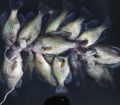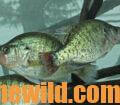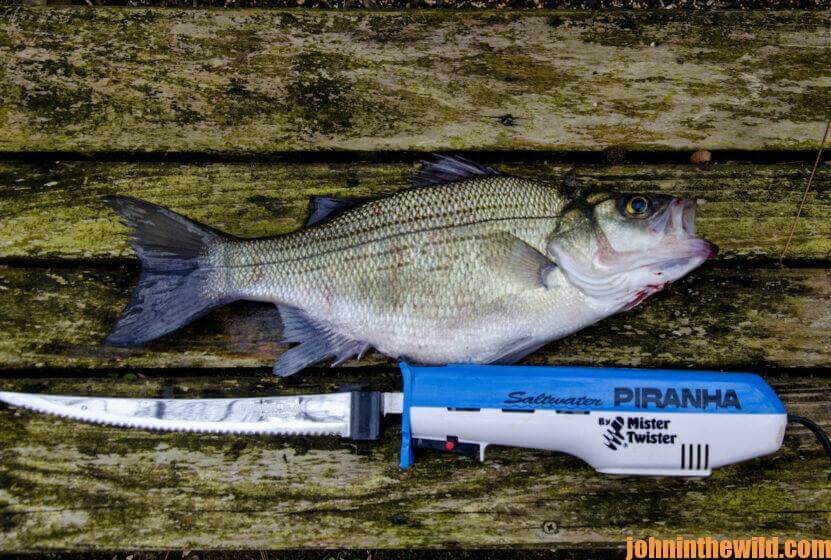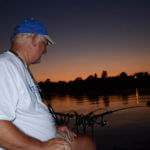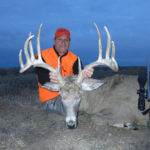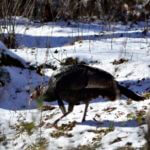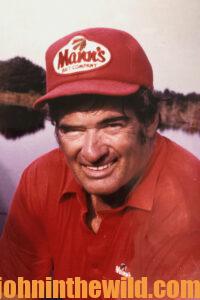 Early in my career as an outdoor writer, I went to Lake Eufaula to fish with the late Tom Mann, the founder of Mann’s Bait Company and a top professional bass angler. Mann was a game warden before he started making and selling bass lures. His first major bait was the Mann’s Jelly Worm. Up until that time, most of the plastic worms being made were created from a tough, hard plastic that didn’t have much action built into the lure. But once Mann made the Jelly worms, he set the world of bass fishing on fire. The lure came out with a wide variety of colors and scents. His next big hit was a lead-headed tail spinner called the Little George (named for Governor George Wallace of Alabama at that time).
Early in my career as an outdoor writer, I went to Lake Eufaula to fish with the late Tom Mann, the founder of Mann’s Bait Company and a top professional bass angler. Mann was a game warden before he started making and selling bass lures. His first major bait was the Mann’s Jelly Worm. Up until that time, most of the plastic worms being made were created from a tough, hard plastic that didn’t have much action built into the lure. But once Mann made the Jelly worms, he set the world of bass fishing on fire. The lure came out with a wide variety of colors and scents. His next big hit was a lead-headed tail spinner called the Little George (named for Governor George Wallace of Alabama at that time).
After catching several good-sized largemouths early in the morning on my first trip with Tom Mann, he asked me, “You want to have some fun?” and I answered, “Of course I do!” So, we went to the back end of a creek where the water came over some shoals and a deep hole below the shoals. Mann tied on a Little George to his spinning rod, and I did the same. “Cast toward those shoals, and as soon as the Little George hits the water, start reeling slowly and hang on,” Mann instructed. We started catching white bass in the 1 – 1-1/2 pound size – on every cast.
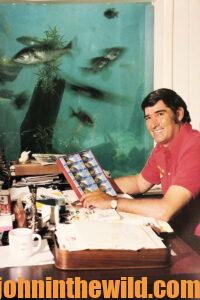 After about 45 minutes or so, Mann asked, “You want to catch some big ones now?” I smiled and answered “Of course!” Mann said, “When the Little George hits the water, instead of starting to reel, let it fall almost to the bottom. Then, watch your line, and when it twitches, set the hook.” Following Mann’s instructions, after casting, I allowed the Little George to fall, saw the twitch on the line, and brought in a 2.75 pound white bass. We continued to catch those bigger white bass with this technique. Now, any time I want to catch white bass, I’ll usually fish a Little George or a fairly-heavy lead tail spinner like the Little George and let it fall through the school of white bass down to the bigger fish that hold below the smaller white bass.
After about 45 minutes or so, Mann asked, “You want to catch some big ones now?” I smiled and answered “Of course!” Mann said, “When the Little George hits the water, instead of starting to reel, let it fall almost to the bottom. Then, watch your line, and when it twitches, set the hook.” Following Mann’s instructions, after casting, I allowed the Little George to fall, saw the twitch on the line, and brought in a 2.75 pound white bass. We continued to catch those bigger white bass with this technique. Now, any time I want to catch white bass, I’ll usually fish a Little George or a fairly-heavy lead tail spinner like the Little George and let it fall through the school of white bass down to the bigger fish that hold below the smaller white bass.
“Those big white bass are smarter than those young white bass schooling on the top,” Mann explained. “Those fish schooling on top are slashing, hitting, biting and cutting those schools of shad. But they’re also expending a lot of energy. The larger white bass, and often largemouth bass, will be holding under the school of smaller white bass feeding on and near the surface. As those injured shad fall below the school, those bigger white bass and largemouths will move over to eat those wounded shad and not expend near the energy that the schooling fish on top are expending.”
How to Clean a White Bass to Be Delicious to Eat
White bass are the most underutilized food fish in the nation, however, they’re one of the most flavorful and delicious fish to eat if you know how to prepare them after you catch them. If you’ll try the technique shown in the photos, you’ll never throw back a white bass.
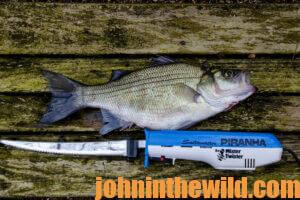
1) Use an electric knife – it’s the quickest and easiest way to clean fish.
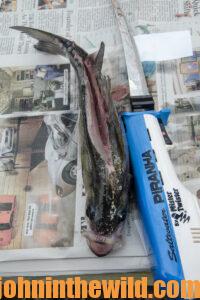 2) Make a cut along the top of the white bass next to the dorsal fin. Extend that cut all the way to the fish’s head, and then all the way to the fish’s tail, so that the cut separates the meat from the backbone all the way down to the rib cage.
2) Make a cut along the top of the white bass next to the dorsal fin. Extend that cut all the way to the fish’s head, and then all the way to the fish’s tail, so that the cut separates the meat from the backbone all the way down to the rib cage.
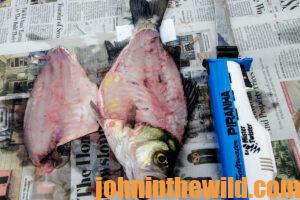
3) Make a cut connecting the cut you’ve made on the top of the fish all the way to the bottom of the fish. Begin to separate the meat from the backbone and the stomach cavity, creating a fillet.
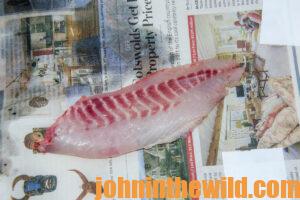 4) Use an electric knife to cut down to the skin of the fish, and remove the fillet that’s above the backbone.
4) Use an electric knife to cut down to the skin of the fish, and remove the fillet that’s above the backbone.
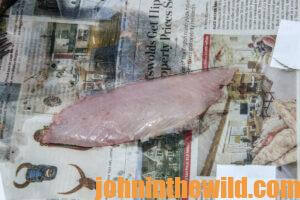 5)Turn the fillet over, and cut the red meat (as seen here in the picture) off the fillet.
5)Turn the fillet over, and cut the red meat (as seen here in the picture) off the fillet.
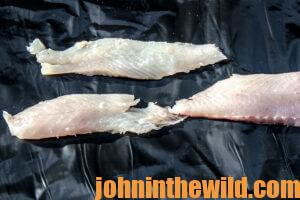 6) Put the fillets in an ice chest or a gallon Ziploc bag, depending on the number of fillets you want to cook.
6) Put the fillets in an ice chest or a gallon Ziploc bag, depending on the number of fillets you want to cook.
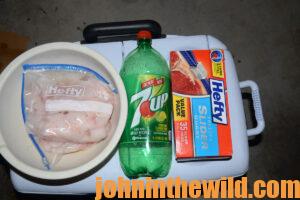 7) Put ice over the fish fillets and pour 7-Up to cover the fillets and the ice. If I’m using a Ziploc bag, I’ll put the fillets in the refrigerator. If I have more fillets that will fill up a half-gallon Ziploc bag, I’ll put the fillets in an ice chest and let them soak overnight.
7) Put ice over the fish fillets and pour 7-Up to cover the fillets and the ice. If I’m using a Ziploc bag, I’ll put the fillets in the refrigerator. If I have more fillets that will fill up a half-gallon Ziploc bag, I’ll put the fillets in an ice chest and let them soak overnight.
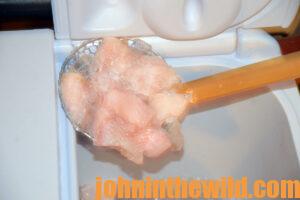 8) Pour the 7-Up and ice off of the fillets the next day. Batter the fillets with some type of fish fry, or a combination of corn meal, flour and spices, and drop them in oil to fry. (If you prefer to bake or boil the fillets, you can do that). The 7-up pulls any oil out of the fillets that may remain after you’ve cut off the red meat, and the fillets will have a much-milder and a much-sweeter taste.
8) Pour the 7-Up and ice off of the fillets the next day. Batter the fillets with some type of fish fry, or a combination of corn meal, flour and spices, and drop them in oil to fry. (If you prefer to bake or boil the fillets, you can do that). The 7-up pulls any oil out of the fillets that may remain after you’ve cut off the red meat, and the fillets will have a much-milder and a much-sweeter taste.
So, the next time you go fishing, if you’re having a hard time catching enough catfish or crappie for a good fish fry, catch a limit of white bass, and use this technique to clean them. I promise you, you’ll be surprised at how flavorful these fish can be.
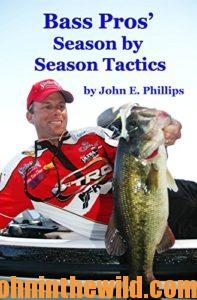 To learn more about catching bass, check out John E. Phillips’ book, “Bass Pros: Season by Season Tactics,” available in Kindle at https://www.amazon.com/ and at https://www.amazon.com/
To learn more about catching bass, check out John E. Phillips’ book, “Bass Pros: Season by Season Tactics,” available in Kindle at https://www.amazon.com/ and at https://www.amazon.com/
for Audible and print versions. (On right side of the Audible page for this book and below the offer for free Audible trial, you can click on Buy the Audible with one click). You may have to copy and paste this click into your browser. (When you click on this book, notice on the left where Amazon says you can read and hear 10% of the book for free). On the right side of the page and below the offer for a free Audible trial, you can click on Buy the Audible book.

